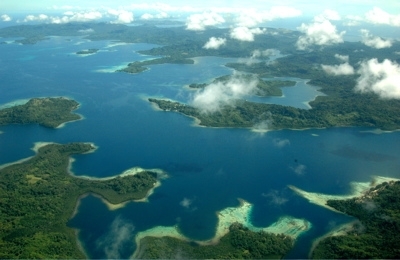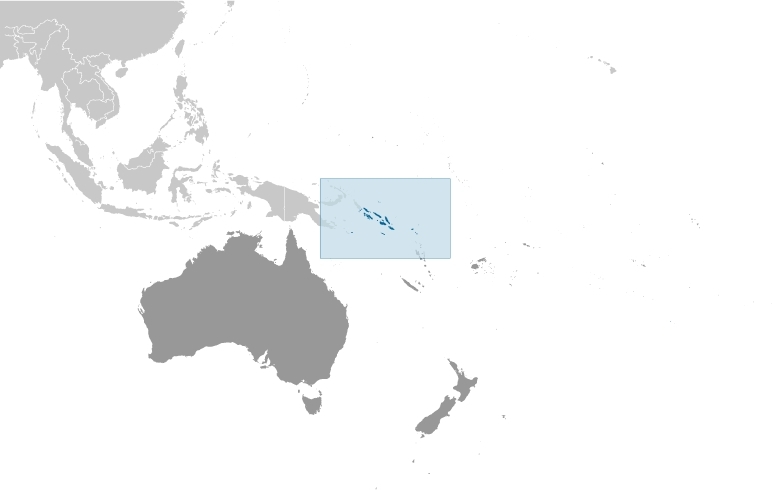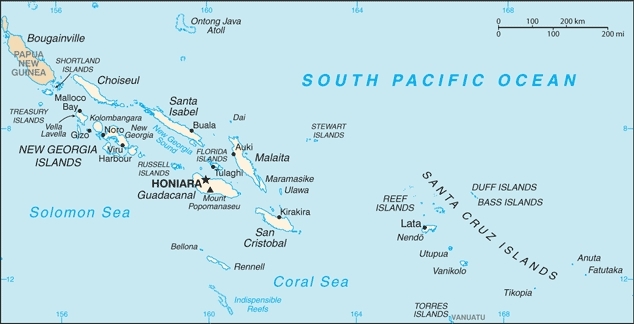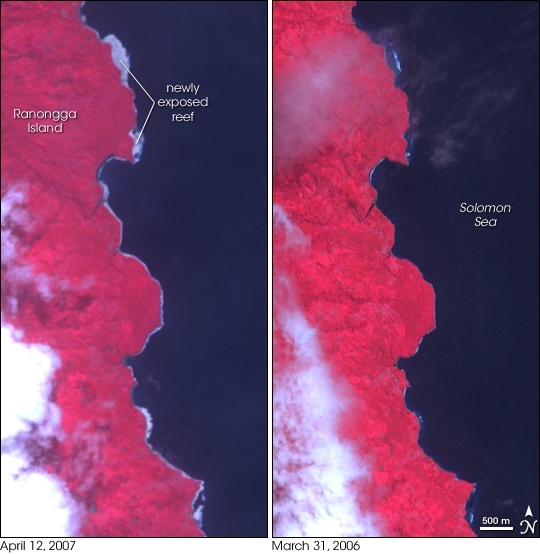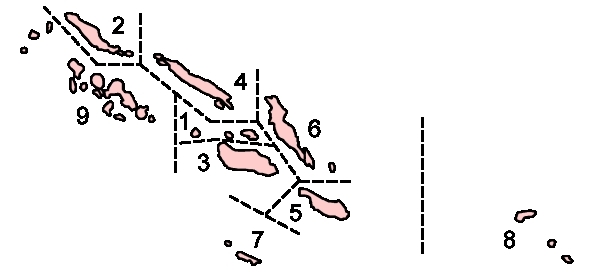Solomon Islands
Countries and Regions of the World Collection  The Solomon Islands are group of islands in the South Pacific Ocean, east of Papua New Guinea, with a population of about 580,000.
The Solomon Islands are group of islands in the South Pacific Ocean, east of Papua New Guinea, with a population of about 580,000.
The islands are predominantly hill forest, although only small portions of a few of the islands extend beyond 1,000 m in elevation. The mountains on Guadalcanal reach past 2,000 m.
Its major environmental issues include:
- deforestation;
- soil erosion; and,
- many of the surrounding coral reefs are dead or dying
The islands are susceptible to typhoons, but rarely destructive.
The Solomons are the result of the subduction of the Australian tectonic plate beneath the Pacific tectonic plate, and the islands are a very active tectonic area with frequent earthquakes, tremors, and tsunamis. on 2 April 2007 an undersea earthquake measuring 8.1 on the Richter scale occurred 345 km WNW of the capital Honiara; the resulting tsunami devastated coastal areas of Western and Choiseul provinces with dozens of deaths and thousands dislocated; the provincial capital of Gizo was especially hard hit.
There is volcanic activity. Tinakula (elev. 851 m) has frequent eruption activity, while an eruption of Savo (elev. 485 m) could affect the capital Honiara on nearby Guadalcanal.
The surface geology of the islands consists predominantly of volcanic rocks, with some metamorphic rocks, uplifted coral islands (Rennell, Bellona, and Ontong Java), and recent (Pliocene to recent) alluvium in the lowlands.
The UK established a protectorate over the Solomon Islands in the 1890s.
Some of the most bitter fighting of World War II occurred on this archipelago.
Self-government was achieved in 1976 and independence two years later.
Ethnic violence, government malfeasance, and endemic crime have undermined stability and civil society.
In June 2003, then Prime Minister Sir Allan Kemakeza sought the assistance of Australia in reestablishing law and order; the following month, an Australian-led multinational force arrived to restore peace and disarm ethnic militias. The Regional Assistance Mission to the Solomon Islands (RAMSI), consisting of police, military, and civilian advisors drawn from 15 countries, has assisted in reestablishing and maintaining civil and political order while reinforcing regional stability and security
The Solomon Islands have a strategic location on sea routes between the South Pacific Ocean, the Solomon Sea, and the Coral Sea.
Contents
Geography
Solomon Islands forms an archipelago in the Southwest Pacific about 1,900 kilometers (1,200 mi.) northeast of Australia. With terrain ranging from ruggedly mountainous islands to low-lying coral atolls, Solomon Islands stretches in a 1,450-kilometer (900 mi.) chain southeast from Papua New Guinea across the Coral Sea to Vanuatu.
The main islands of Choiseul, New Georgia, Santa Isabel, Guadalcanal, Malaita, and Makira have rainforested mountain ranges of mainly volcanic origin, deep narrow valleys, and coastal belts lined with coconut palms and ringed by reefs. The smaller islands are atolls and raised coral reefs, often spectacularly beautiful. The region is geologically active, and earth tremors are frequent.
The islands' ocean-equatorial climate is extremely humid throughout the year, with a mean temperature of 27° C (80° F) and few extremes of temperature or weather. June through August is the cooler period. Though seasons are not pronounced, the northwesterly winds of November through April bring more frequent rainfall and occasional squalls or cyclones. The annual rainfall is about 305 centimeters (120 in.).
More than 90% of the islands traditionally were forested, but this has come under severe pressure from current logging operations. The coastal strips are sheltered by mangrove and coconut trees. Luxuriant rainforest covers the interiors of the large islands. Soil quality ranges from extremely rich volcanic to relatively infertile limestone. More than 230 varieties of orchids and other tropical flowers brighten the landscape.
Location: Oceania, group of islands in the South Pacific Ocean, east of Papua New Guinea
Geographic Coordinates: 8 00 S, 159 00 E
Area: 28,896 sq km(land: 27,986 sq km; water: 910 sq km)
Coastline: 5,313 km
Maritime Claims:
measured from claimed archipelagic baselines
territorial sea: 12 nm
exclusive economic zone: 200 nm
continental shelf: 200 nm
Natural Hazards: typhoons, but rarely destructive; geologically active region with frequent earthquakes, tremors, and volcanic activity; tsunamis.
Terrain: mostly rugged mountains with some low coral atolls. The highest point is Mount Popomanaseu (2,310 m).
Climate: tropical monsoon; few extremes of temperature and weather
Ecology and Biodiversity
Ecologically, most of the Solomon Islands are within the Solomon Islands rain forests ecoregion which consists of tropical lowland and montane forests on Bougainville and Buka Islands in Papua New Guinea (PNG) and most of the island nation of the Solomon Islands (not including the Santa Cruz Group). The most widespread vegetation type is lowland rain forest. The canopy is uneven as a result of frequent natural disturbance (tropical storms, landslips, treefalls).
East Rennell is a Natural World Heritage Site. It is the southernmost island in the Solomons, and covers portions of the Rennell and Bellona Province. Rennell Island is located approximately 180 kilometers (km) to the south of Guadalcanal and to the south-west of San Cristobal.
In the early morning hours of April 2, 2007, a magnitude 8.1 earthquake shook the Solomon Islands, its epicenter southwest of Ranongga Island. The huge quake pushed much of the island up, raising the coral reefs that ringed the island above the water. In the course of a few minutes, Ranongga Island acquired several meters of new beach.
The newly exposed reef forms a gray rim along the eastern shore of the island in the left image, acquired by the Advanced Spaceborne Thermal Emission and Reflection Radiometer (ASTER) on April 12, 2007. In the right image, taken on March 31, 2006, the shallowly submerged reefs color the water a lighter shade of blue. The uplift may be more dramatic than the images show. When ASTER took the 2007 image, the tide was 29.4 centimeters higher than it was when the 2006 image was taken, and yet the uplift is still visible. The lush vegetation that covers the tropical island is bright red in this image, which is made from both visible and infrared light.
Out of its aquatic environment, the reef died, becoming the foundation of new land. Such evolution is common in earthquake zones in the Pacific and Indian Oceans. During the December 26, 2004, earthquake that generated the massive Indian Ocean tsunami, Simeulue Island was lifted as much as 150 centimeters (4.9 feet), exposing the reef that surrounded it. A similar set of exposed fossilized reefs on the shores of Papua New Guinea, near the Solomon Islands, provided proof that wobbles in the Earth’s orbit trigger ice ages.
Source: NASA. Credit: image created by Jesse Allen, using data provided courtesy of the NASA/GSFC/MITI/ERSDAC/JAROS, and U.S./Japan ASTER Science Team.Thanks to Aron Meltzner, California Institute of Technology, for help with image interpretation.
People and Society
Population: 584,578 (July 2012 est.)
Solomon Islanders comprise diverse cultures, languages, and customs. Ninety-three percent are Melanesian, 4% Polynesian, and 1.5% Micronesian. In addition, small numbers of Europeans and Chinese are registered. About 120 vernacular languages are spoken.
Most people reside in small, widely dispersed settlements along the coasts. Sixty percent live in localities with fewer than 200 persons, and only 17% reside in urban areas.
The capital city of Honiara, situated on Guadalcanal, the largest island, has 66,000 inhabitants. The other principal towns are Gizo, Auki, and Kirakira.
Most Solomon Islanders are Christian, with the Anglican, Roman Catholic, South Seas Evangelical, and Seventh-day Adventist faiths predominating. About 5% of the population maintains traditional beliefs.
The chief characteristics of the traditional Melanesian social structure are:
- The practice of subsistence economy;
- The recognition of bonds of kinship, with important obligations extending beyond the immediate family group; local and clan loyalties far outweigh regional or national affiliations.
- Generally egalitarian relationships, emphasizing acquired rather than inherited status; and
- A strong attachment of the people to the land.
Most Solomon Islanders maintain this traditional social structure and find their roots in village life.
Ethnic Groups: Melanesian 94.5%, Polynesian 3%, Micronesian 1.2%, other 1.1%, unspecified 0.2% (1999 census)
Age Structure:
0-14 years: 37.8% (male 111,265/female 104,896)
15-64 years: 58.3% (male 169,873/female 163,621)
65 years and over: 3.9% (male 10,879/female 11,356) (2011 est.)
Population Growth Rate: 2.17% (2012 est.)
Birthrate: 27.46 births/1,000 population (2012 est.)
Death Rate: 3.91 deaths/1,000 population (July 2012 est.)
Net Migration Rate: -1.86 migrant(s)/1,000 population (2012 est.)
Life Expectancy at Birth: 74.42 years
male: 71.83 years
female: 77.14 years (2012 est.)
Total Fertility Rate: 3.51 children born/woman (2012 est.)
Languages: Melanesian pidgin (in much of the country is lingua franca), English (official but spoken by only 1%-2% of the population), 120 indigenous languages
Urbanization: 19% of total population (2010) growing at annual rate of change of 4.2% (2010-15 est.)
History
Although little prehistory of Solomon Islands is known, material excavated on Santa Ana, Guadalcanal, and Gawa indicates that a hunter-gatherer people lived on the larger islands as early as 1000 B.C. Some Solomon Islanders are descendants of Neolithic Austronesian-speaking peoples who migrated from Southeast Asia.
The European discoverer of Solomon Islands was the Spanish explorer Alvaro de Mendana Y Neyra, who set out from Peru in 1567 to seek the legendary Isles of Solomon. British mariner Philip Carteret entered Solomon waters in 1767. In the years that followed, visits by explorers were more frequent.
Missionaries began visiting Solomon Islands in the mid-1800s. They made little progress at first, because "blackbirding"--the often brutal recruitment of laborers for the sugar plantations in Queensland and Fiji--led to a series of reprisals and massacres. The evils of the labor trade prompted the United Kingdom to declare a protectorate over the southern Solomons in 1893. In 1898 and 1899, more outlying islands were added to the protectorate; in 1900 the remainder of the archipelago, an area previously under German jurisdiction, was transferred to British administration. Under the protectorate, missionaries settled in Solomon Islands, converting most of the population to Christianity.
In the early 20th century, several British and Australian firms began large-scale coconut planting. Economic growth was slow, however, and the islanders benefited little. With the outbreak of World War II, most planters and traders were evacuated to Australia, and most cultivation ceased.
From May 1942, when the Battle of the Coral Sea was fought, until December 1943, the Solomons were almost constantly a scene of combat. Although U.S. forces landed on Guadalcanal virtually unopposed in August 1942, they were soon engaged in a bloody fight for control of the islands' airstrip, which the U.S. forces named Henderson Field. One of the most furious sea battles ever fought took place off Savo Island, near Guadalcanal, also in August 1942. Before the Japanese completely withdrew from Guadalcanal in February 1943, over 7,000 Americans and 21,000 Japanese died. By December 1943, the Allies were in command of the entire Solomon chain. The large-scale American presence toward the end of the war, which dwarfed anything seen before in the islands, triggered various millennial movements and left a lasting legacy of friendship.
Postwar Developments
Following the end of World War II, the British colonial government returned. The capital was moved from Tulagi to Honiara to take advantage of the infrastructure left behind by the U.S. military. A native movement known as the Marching Rule defied government authority. There was much disorder until some of the leaders were jailed in late 1948. Throughout the 1950s, other indigenous dissident groups appeared and disappeared without gaining strength.
In 1960, an advisory council of Solomon Islanders was superseded by a legislative council, and an executive council was created as the protectorate's policymaking body. The council was given progressively more authority.
In 1974, a new constitution was adopted establishing a parliamentary democracy and ministerial system of government. In mid-1975, the name Solomon Islands officially replaced that of British Solomon Islands Protectorate. On January 2, 1976, Solomon Islands became self-governing, and independence followed on July 7, 1978.
Recent History
Solomon Islands governments are characterized by weak political parties and highly unstable parliamentary coalitions. They are subject to frequent votes of no confidence, and government leadership changes frequently as a result. Cabinet changes are common.
The first post-independence government was elected in August 1980. Prime Minister Peter Kenilorea was head of government until September 1981, when he was succeeded by Solomon Mamaloni as the result of a realignment within the parliamentary coalitions. Following the November 1984 elections, Kenilorea was again elected Prime Minister, to be replaced in 1986 by his former deputy Ezekiel Alebua following shifts within the parliamentary coalitions. The next election, held in early 1989, returned Solomon Mamaloni as Prime Minister. Francis Billy Hilly was elected Prime Minister following the national elections in June 1993, and headed the government until November 1994 when a shift in parliamentary loyalties brought Solomon Mamaloni back to power. The national election of August 6, 1997 resulted in Bartholomew Ulufa'alu's election as Prime Minister, heading a coalition government, which christened itself the Solomon Islands Alliance for Change.
However, governance was slipping as the performance of the police and other government agencies deteriorated due to ethnic rivalries. The capital of Honiara on Guadalcanal was increasingly populated by migrants from the island of Malaita. In June 2000, an insurrection mounted by militants from the island of Malaita resulted in the brief detention of Ulufa'alu and his subsequent forced resignation. Manasseh Sogavare, leader of the People's Progressive Party, was chosen Prime Minister by a loose coalition of parties. Guadalcanal militants retaliated and sought to drive Malaitan settlers from Guadalcanal, resulting in the closure of a large oil-palm estate and gold mine which were vital to exports but whose workforce was largely Malaitan.
New elections in December 2001 brought Sir Allan Kemakeza into the Prime Minister's chair with the support of a coalition of parties. Kemakeza attempted to address the deteriorating law and order situation in the country, but the prevailing atmosphere of lawlessness, widespread extortion, and ineffective police prompted a formal request by the Solomon Islands Government for outside help. With the country bankrupt and the capital in chaos, the request was unanimously supported in Parliament.
The Regional Assistance Mission to the Solomon Islands (RAMSI), a multinational police-centered force organized by Australia, arrived in the country in 2003 at the government's invitation to assist in restoring law and order and rebuilding the country's institutions. The peace proved to be fragile, and fierce rioting occurred soon after the April 2006 general election and the election of Snyder Rini as Prime Minister in mid-April. Most of the violence was directed against businesses owned by ethnic Chinese in Honiara, with the almost complete destruction of the Chinatown commercial district. Rini resigned shortly after the riots, and a parliamentary vote saw Manasseh Sogavare elected as the new Prime Minister in May 2006. The civilian authorities generally maintained effective control of the security forces.
Relations between RAMSI and the Sogavare government were increasingly strained after the controversial July 2007 appointment of Julian Moti, wanted by Australia on child sex offense charges, as attorney general. On December 13, Prime Minister Manasseh Sogavare's coalition government lost a parliamentary vote of no confidence, and on December 20, Parliament elected Derek Sikua as Prime Minister. In December 2007 the Sikua government dismissed Moti and deported him to Australia. Australian Prime Minister Kevin Rudd's visit to the Solomon Islands in March 2008 began a new era of bilateral relations. Sikua served as Prime Minister until the dissolution of Parliament on April 24, 2010 for national elections. The elections were held in August 2010 and veteran politician Danny Philip was elected Prime Minister by a majority of one. Philip resigned on November 11, 2011 when all his coalition members deserted him ahead of a vote of no confidence. Philip’s former Minister for Finance and Treasury, Gordon Darcy Lilo, was elected Prime Minister on November 16 with 29 votes out of 50. The next national elections will be held in 2014.
Government
Government Type: parliamentary democracy and a Commonwealth realm.
Solomon Islands is a parliamentary democracy within the Commonwealth, with a unicameral Parliament and a ministerial system of government. Queen Elizabeth II is represented by a governor general, chosen by the Parliament for a 5-year term. The national Parliament has 50 members, elected for 4-year terms. However, Parliament may be dissolved by majority vote of its members before the completion of its term. Parliamentary representation is based on single-member constituencies. Suffrage is universal for citizens over age 18. The prime minister, elected by Parliament, chooses the other members of the cabinet. Each ministry is headed by a cabinet member, who is assisted by a permanent secretary, a career public servant, who directs the staff of the ministry.
For local government, the country is divided into 10 administrative areas, of which nine are provinces administered by elected provincial assemblies, and the 10th is the town of Honiara, administered by the Honiara Town Council.
Land ownership is reserved for Solomon Islanders. At the time of independence, citizenship was granted to all persons whose parents are or were both British protected persons and members of a group, tribe, or line indigenous to Solomon Islands. The law provides that resident expatriates, such as the Chinese and Kiribati, may obtain citizenship through naturalization. Land generally is still held on a family or village basis and may be handed down from mother or father according to local custom. The islanders are reluctant to provide land for nontraditional economic undertakings, and this has resulted in continual disputes over land ownership.
No military forces are maintained by the Solomon Islands, although the police force of 1,059 includes a border protection element. The police also have responsibility for fire service, disaster relief, and maritime surveillance. The police force is headed by a commissioner, appointed by the governor general and responsible to the prime minister. Peter Marshall, a New Zealander, was appointed as police commissioner in May 2008. His contract ended in early 2011 and Walter Kola, a local official, became acting police commissioner.
|
Capital: Honiara - 72,000 (2009) Administrative divisions: 9 provinces and 1 capital territory (Honiara)
|
Independence Date: 7 July 1978 (from the UK)
Legal System: The Solomon Islands accepts compulsory International Court of Justice (ICJ) jurisdiction; and accepts International criminal court (ICCt) jurisdiction
International Environmental Agreements
The Solomon Islands is party to international agreements on: Biodiversity, Climate Change, Climate Change-Kyoto Protocol, Desertification, Environmental Modification, Law of the Sea, Marine Dumping, Marine Life Conservation, Ozone Layer Protection, and Whaling.
Water
Total Renewable Water Resources: 44.7 cu km (1987)
Access to improved sources of drinking water: 70% of population
Access to improved sanitation facilities: 31% of population
Resources
Natural Resources: fish, forests, gold, bauxite, phosphates, lead, zinc, nickel
Land Use:
Economy
In 2010 the economy recovered and grew by an estimated 5.6%, after contracting in 2009 because of the global financial crisis. Overall production in 2010 returned to 2008 levels according to the Central Bank of the Solomon Islands. This was largely due to the increase in international prices and demand for logs, especially in late 2010, as well as increases in international prices for Solomon Islands’ cash crops (with the exception of cocoa).
More than 75% of Solomon Islands’ labor force engages in subsistence farming and fishing. Until 1998, when world prices for tropical timber fell steeply, timber was Solomon Islands' main export product, and, in recent years, Solomon Islands forests were dangerously overexploited. The government has said it would reform timber harvesting policies with the aim of carrying out logging on a more sustainable basis. Other important cash crops and exports include copra and palm oil. In 1998 Ross Mining of Australia began producing gold at Gold Ridge on Guadalcanal, and other areas have seen minerals exploration.
In the wake of the June 2000 ethnic violence, exports of palm oil and gold ceased and exports of timber fell. Solomon Islands had been particularly hard hit by the Asian economic crisis even before the ethnic violence of June 2000. The Asian Development Bank estimates that the crash of the market for tropical timber reduced Solomon Island's GDP by between 15% and 25%. About one-half of all jobs in the timber industry were lost. An upward trend in log exports began in 2001 but ended in 2009 as international demand and particularly Asian market demand fell due to the effects of the global financial crisis. The recovery of its export partners' economies in 2010 saw an increase in Solomon Islands' log export volumes once again. However, this was seen by some as an unsustainable exploitation of forest resources, raising questions about the quality of the country's economic growth.
Due to financial insolvency and following the RAMSI intervention in 2003, the Solomon Islands Government had recast its budget and had taken a hard look at priorities. It consolidated and renegotiated its domestic debt and with Australian backing sought to renegotiate its foreign obligations. Much work remains to be done. Political instability has negatively impacted economic development.
Exploitation of Solomon Islands' rich fisheries offers the best prospect for further export and domestic economic expansion. A Japanese joint venture, Solomon Taiyo Ltd., which operated the only fish cannery in the country, closed in mid-2000 as a result of the ethnic disturbances. The plant later reopened under local management, and the export of tuna resumed. In October 2009, Australian company Allied Gold took over operation of the Gold Ridge mine and in March 2010 announced a U.S. $150 million plan to reopen the mine, with mining operations beginning in the second quarter of 2011. Small-scale production by landowners in the Gold Ridge mining area resulted in the production and export of 130.4 kilograms of alluvial gold in 2009.
Tourism, particularly diving, is an important service industry for Solomon Islands. Growth in that industry is hampered, however, by political instability, security issues, lack of infrastructure, and transportation limitations.
Principal aid donors are Australia, New Zealand, the European Union, Japan, and Taiwan.
GDP: (Purchasing Power Parity): $1.734 billion (2011 est.)
GDP: (Official Exchange Rate): $800 million (2011 est.)
GDP- per capita (PPP): $3,300 (2011 est.)
GDP- composition by sector:
agriculture: 29.8%
industry: 7%
services: 63.2% (2011 est.)
Agricultural products: cocoa beans, coconuts, palm kernels, rice, potatoes, vegetables, fruit; timber; cattle, pigs; fish
Industries: fish (tuna), mining, timber
Currency: Solomon Islands dollars (SBD)
